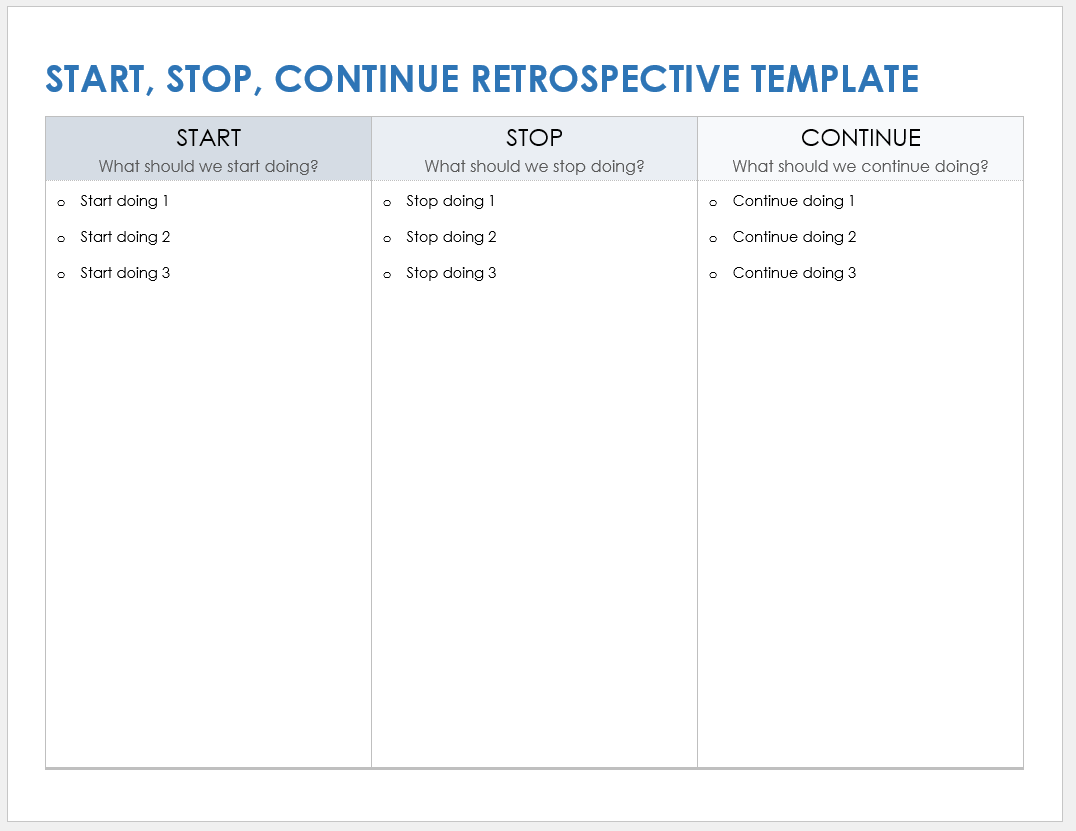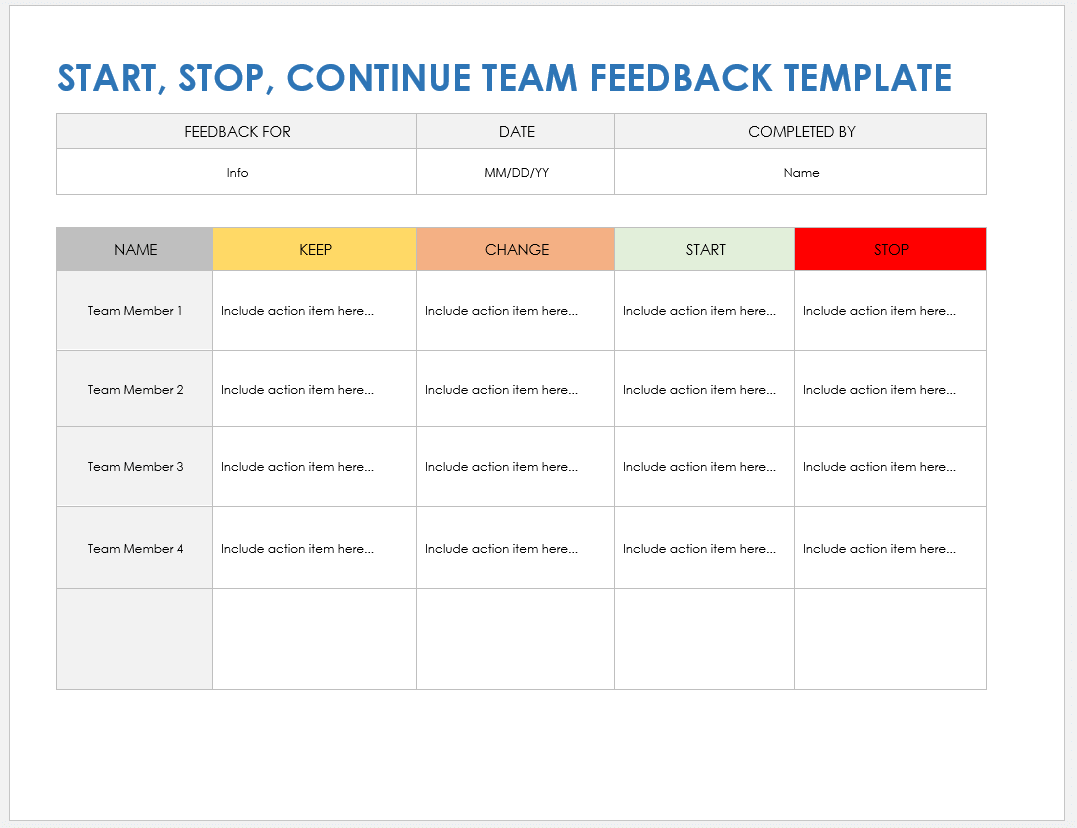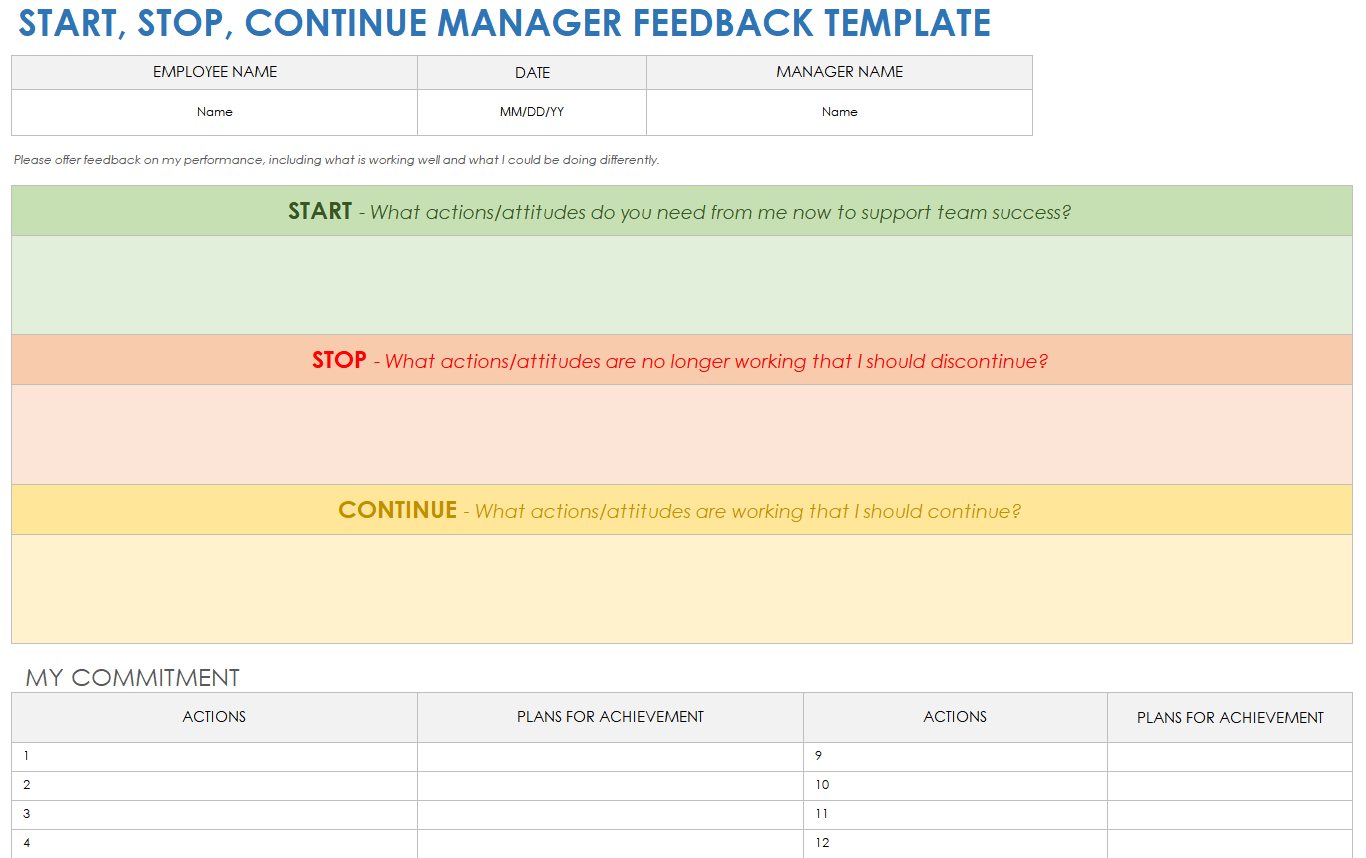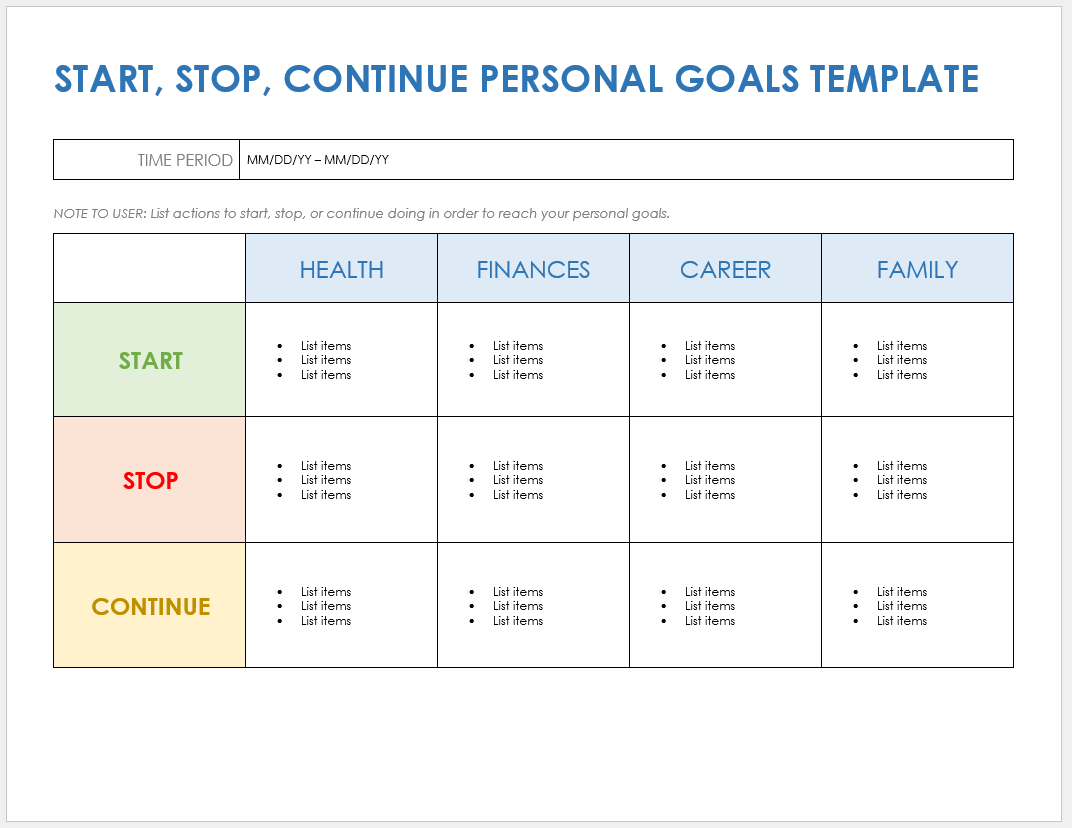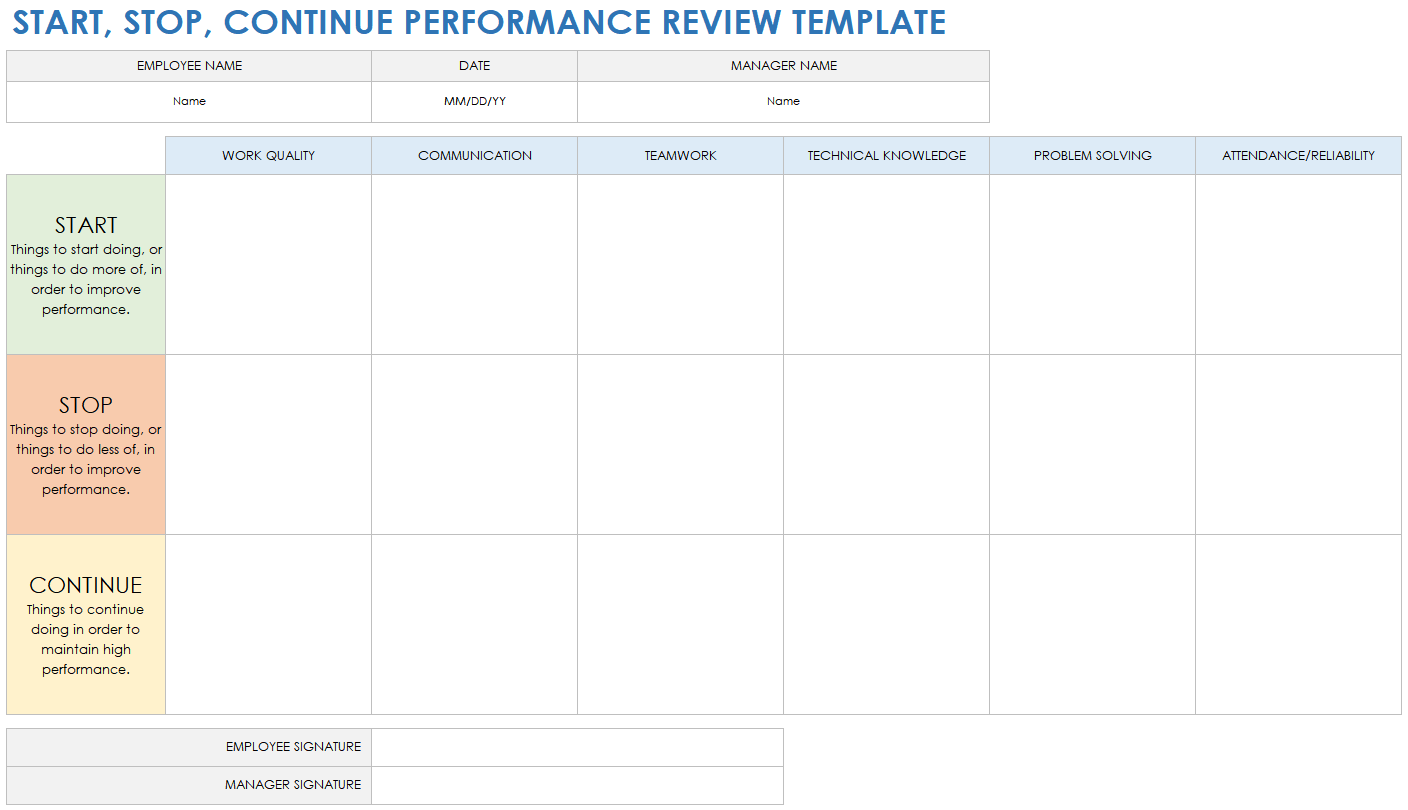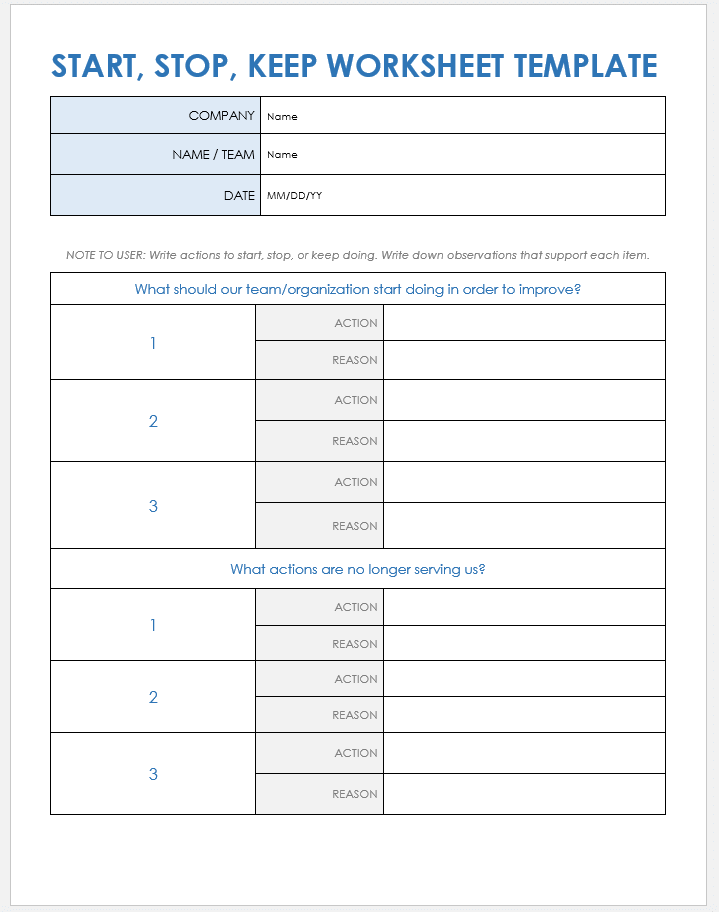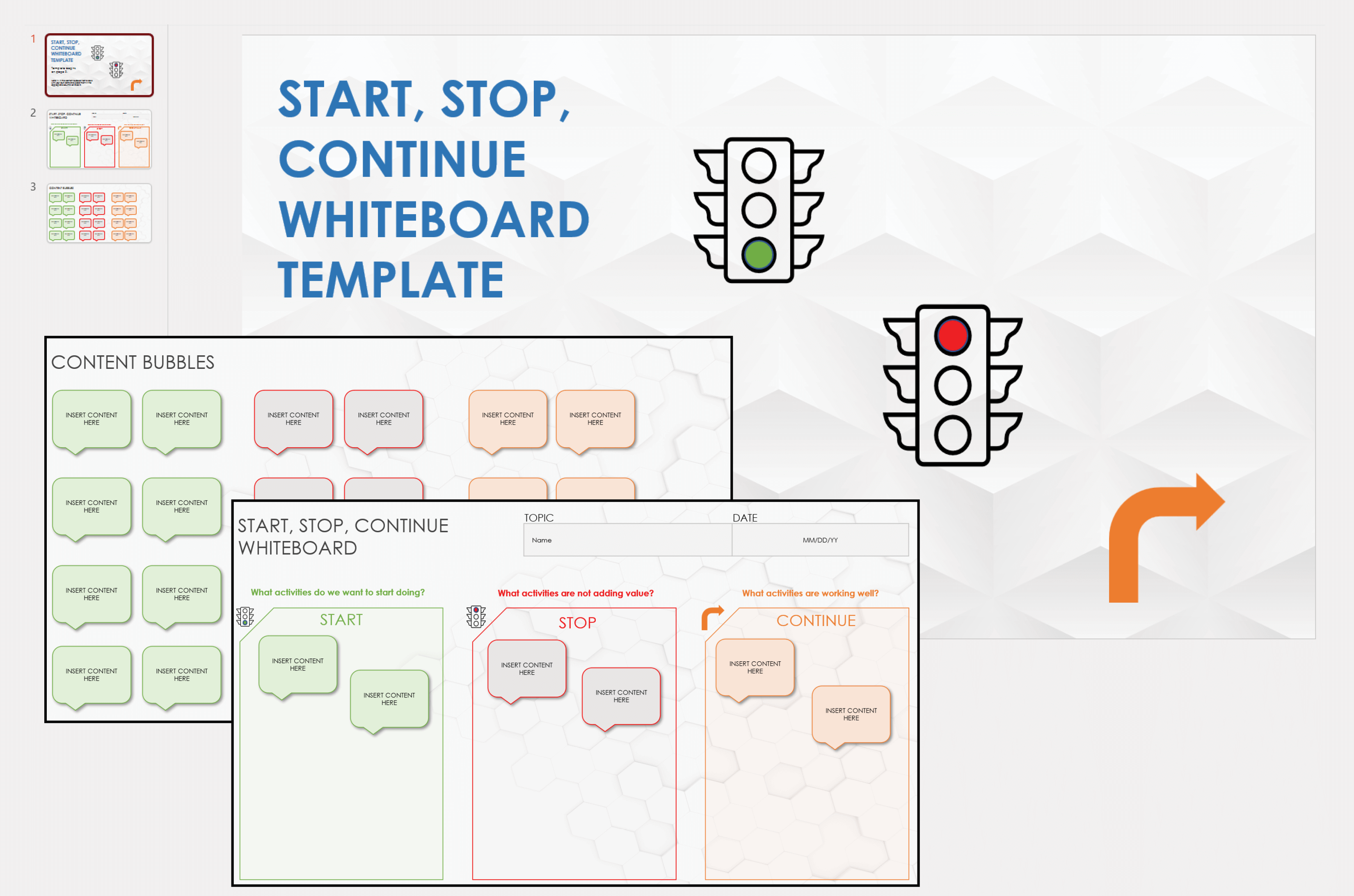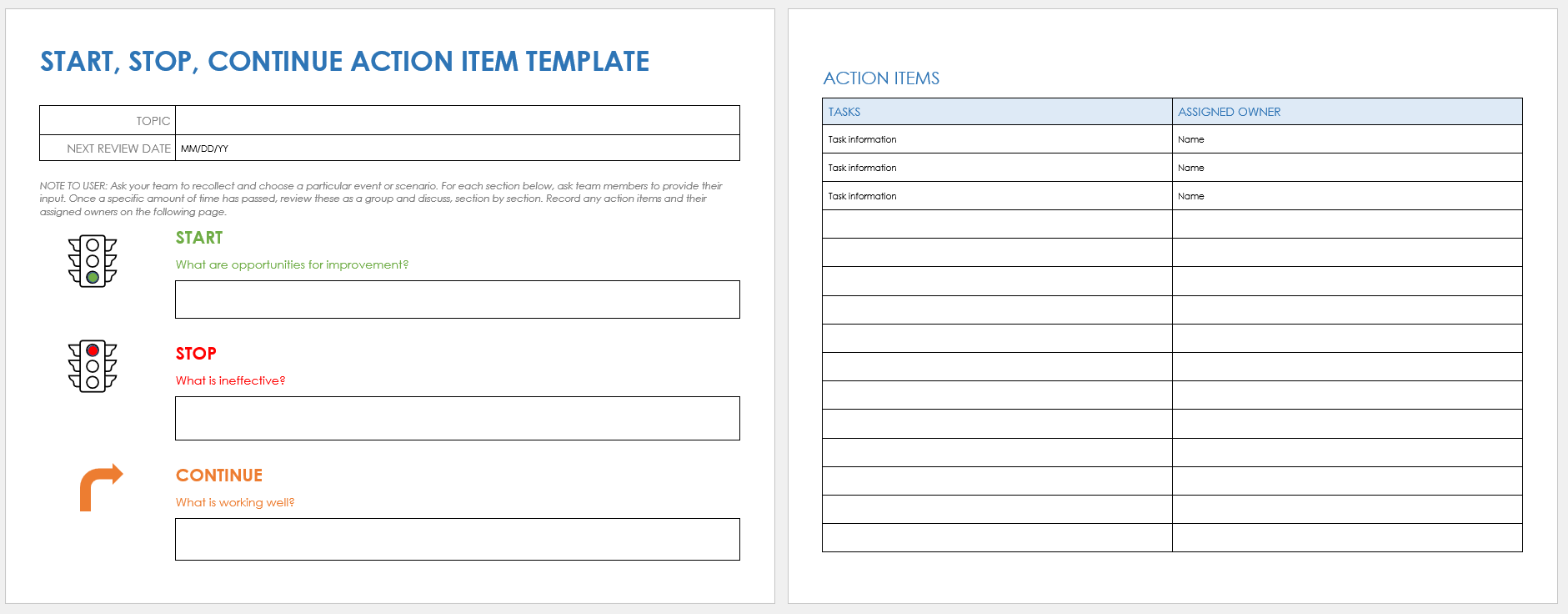Start, Stop, Continue Retrospective Template
Download a Start, Stop, Continue Retrospective Template for
Microsoft Word
|
Adobe PDF
| Google Docs
Conducting start, stop, continue retrospectives at regular intervals can help promote continuous improvement. For example, an Agile team might hold a post-mortem after each sprint or work cycle to analyze what new ideas could be implemented in the new cycle (start), what isn’t working (and should stop), and what is working (and should continue). Ask team members to brainstorm items that could have a positive impact on team or project performance, items that aren’t functioning well or adding enough value, and items that worked well in the last iteration and should continue or become part of standard workflow. Add the items to the corresponding Start, Stop, and Continue columns on the template, and then create an action plan.
Learn more about how to perform Agile retrospectives and find more free tools in our retrospective template collection.
Start, Stop, Continue Team Feedback Template
Download a Start, Stop, Continue Team Feedback Template for
Excel
|
Microsoft Word
|
Adobe PDF
| Google Docs
Use this template to collect feedback from all team members and foster a culture of trust and improvement. Have each member of the group discuss areas of improvement, change, and current effectiveness, and add key points to the template. Then everyone can see how they are contributing to the team and what actions, behaviors, or attitudes they should keep, change, start, or stop to improve overall team effectiveness.
Start, Stop, Continue Manager Feedback Template
Download a Start, Stop, Continue Manager Feedback Template for
Excel
|
Microsoft Word
|
Adobe PDF
This form is designed for managers or other people in leadership roles. Use it to collect feedback from employees; managers can then use it to create an action plan for how to better serve their team and organization. Feedback provides managers with clarity about what they are doing well, what is no longer working, and what new approaches might be more effective. When performed regularly, the feedback process supports trust, accountability, and ongoing improvement.
Start, Stop, Continue Personal Goals Template
Download a Start, Stop, Continue Personal Goals Template for
Microsoft Word
|
Adobe PDF
You can also use the start, stop, continue, method for personal goals. To use this template, edit the column headings to reflect the areas you want to focus on, such as relationships, health, finance, creative projects, or other endeavors. For each category, enter items you want to start doing to get closer to your goals, items to stop doing that are in the way of reaching your goals, and items to continue doing that are in alignment with your goals. This can be for any time period, whether you’re setting yearly resolutions or making a one-month plan.
Start, Stop, Continue Performance Review Template
Download a Start, Stop, Continue Performance Review Template for
Excel
|
Microsoft Word
|
Adobe PDF
A start, stop, continue performance review gives employees specific actions they can take or let go of to boost performance. This template uses a matrix format with multiple columns. Edit the column titles based on the work areas you want to review, and enter actionable items that the employee can continue doing or implement. Use the template as a discussion tool between employees and supervisors, as a self-evaluation exercise, or for delivering concise feedback on any role.
Start, Stop, Keep Worksheet Template
Download a Start, Stop, Keep Worksheet Template for
Microsoft Word
|
Adobe PDF
| Google Docs
This worksheet template asks participants to include supporting evidence for each stop, start, and continue idea that they come up with in a brainstorming session. Provide objective reasons for why an idea should be implemented, so teams or individuals can justify changes and prioritize actions. The worksheet divides each section into multiple rows, which makes the template easy to read and edit.
Start, Stop, Continue Whiteboard Template
Download a Start, Stop, Continue Whiteboard Template for
Microsoft PowerPoint
| Google Slides
Teams often use a whiteboard and sticky notes to carry out a start, stop, continue session. Participants write down ideas on the sticky notes and add them to the appropriate section of the whiteboard. This digital version provides a slide format with virtual sticky notes. Use the template for online or in-person meetings to compile and organize ideas.
Start, Stop, Continue Action Item Template
Download a Start, Stop, Continue Action Item Template for
Microsoft Word
|
Adobe PDF
This template includes a list of action items and assigned owners to help facilitate the shift from brainstorming to implementation. Take the ideas generated during a start, stop, continue analysis, and write down specific action steps. Identify who is responsible for each item, and add dates for even greater specificity and accountability.
What Is Start, Stop, Continue?
Start, stop, continue is a feedback exercise that works at the individual, team, and organizational levels. It is a simple yet valuable method for collecting feedback on what is and isn’t working, as well as new ideas to implement.
The process generates action-oriented ideas in the following three areas:
- Start: What should we implement that we aren’t currently doing? What are the areas to improve?
- Stop: What should we stop doing because it has proven ineffective?
- Continue: What is working well and should be maintained?
The three areas are often represented by a stoplight: red for stop, yellow for continue, and green for start. The order of the elements might vary, but you will always assess the same three areas.
A start, stop, continue session is often conducted as a group, with participants collectively offering feedback or reflections. Once groups are familiar with the process, you can do the exercise in about 20 minutes. The intention is to generate a list of ideas, which you can then narrow down and prioritize. Group members typically vote on which ideas should become top priorities.
What Are the Benefits of Start, Stop, Continue?
The benefits of the stop, start, continue method include determining areas for improvement in quality and work performance, increasing efficiency, reducing waste, and fostering continuous learning and improvement.
Additionally, the method offers the following advantages:
- Builds trust and open communication
- Encourages collaboration and shared priorities
- Gives individuals and teams ownership over improvement
- Offers alternative to employee performance reviews
- Supports behavioral change
- Works at individual and collective levels
Another benefit is the simplicity of the model. A start, stop, continue session is typically brief but impactful, providing practical feedback that you can act on immediately.
When to Use Start, Stop, Continue
The start, stop, continue framework is often used in retrospectives to improve team effectiveness and productivity. You can also use the method to do the following:
- Achieve goals (and understand what is in the way of reaching them)
- Analyze product strategies
- Conduct employee evaluations
- Evaluate an event
- Examine work processes
- Get feedback from customers or partners
- Monitor a project
- Review leadership performance
As a problem-solving and review tool, the start, stop, continue method can be applied to individuals, projects, teams, programs, and products. Smaller businesses can use the model to evaluate the company as a whole.
Start, Stop, Continue Examples
You can use the start, stop, continue method in many situations, from project management to classroom feedback to personal goals and relationships. Here are four examples:
Start, Stop, Continue Manager Feedback Example
Managers in all settings can use feedback to grow and improve in their positions, whether it’s a manager of a retail store or a project manager leading a team. Responses from this exercise might look like the following:
Start:
- End meetings on time.
- Give more consistent feedback to team members.
Stop:
- Arrive late to meetings.
- Change the agenda during meetings.
Continue:
- Host one-on-one check-ins with no agenda.
- Solve problems creatively.
- Hold yourself and others accountable.
Managers can use this information to take concrete actions to improve their own and the team’s performance.
Start, Stop, Continue Team Example
As a group exercise, stop, start, continue can build trust and provide a shared action plan. Here is an example focused on team behaviors:
Start:
- Require all team members to be present at review meetings.
- Show up for meetings on time.
Stop:
- End meetings without clarity on next actions.
- Spend too much time debating.
Continue:
- Daily standup meeting to set priorities for the day.
- Group problem-solving and collaboration.
Team members can use this exercise to reflect on their own individual behaviors and as group conduct to increase self-awareness.
Start, Stop Continue Small Business Example
A small business owner might use the start/stop method to produce ideas for increasing sales, attracting and retaining employees, or improving overall business performance. Here is an example focused on marketing and sales:
Start:
- Send an email newsletter to customers.
- Solicit customer reviews.
Stop:
- Start text message marketing.
- Post the same content on multiple platforms.
Continue:
- Use influencer marketing.
- Launch new products quarterly.
Depending on the focus of a start, stop, continue exercise, business owners can get feedback from customers and employees, as well as add their own reflections on what has or hasn’t worked effectively.
Start, Stop, Continue Teacher Example
Teachers can use the start, stop, continue method to collect feedback from students on what activities would enhance learning, are negatively affecting learning, and are currently having a positive impact on learning. Feedback might include these examples:
Start:
- Make sure everyone in class is caught up before moving on.
- Provide more instruction on assignments.
Stop:
- Call on the same people to answer questions.
- Include too much information in presentation slides.
Continue:
- Be accessible and available to students.
- Go over homework.
- Host classroom discussions.
This exercise can also be used to help students evaluate their own performance and classroom dynamics, deciding as a group what behaviors or attitudes should change or continue.
Use Start, Stop, Continue to Achieve Your Goals with Smartsheet
Empower your people to go above and beyond with a flexible platform designed to match the needs of your team — and adapt as those needs change.
The Smartsheet platform makes it easy to plan, capture, manage, and report on work from anywhere, helping your team be more effective and get more done. Report on key metrics and get real-time visibility into work as it happens with roll-up reports, dashboards, and automated workflows built to keep your team connected and informed.
When teams have clarity into the work getting done, there’s no telling how much more they can accomplish in the same amount of time. Try Smartsheet for free, today.
